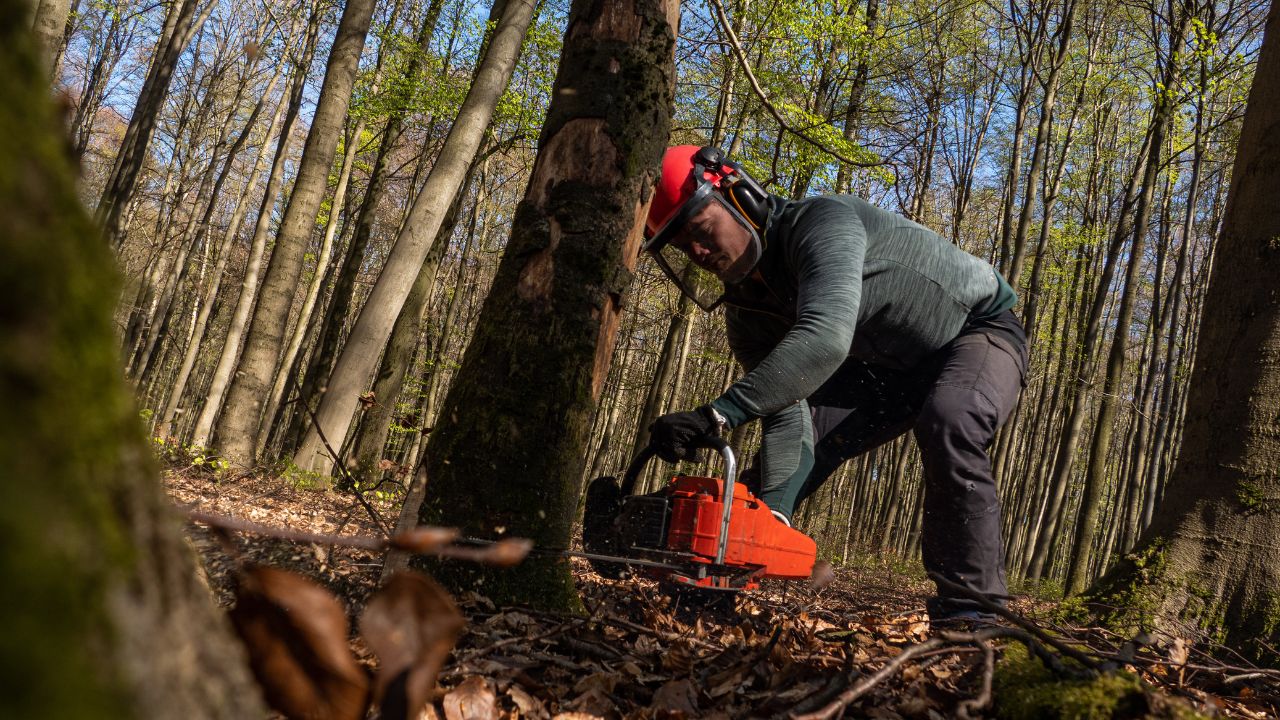Last Updated on November 29, 2023 by Pro Handyman Australia – Editorial Team
Introduction to Chainsaw Safety Gear
The significance of chainsaw safety, especially the importance of protective clothing, cannot be overstated, similarly emphasizing the need for safety awareness in various scroll saw uses. With over 36,000 injuries related to chainsaw usage reported annually in the U.S. and an average cost of $12,000 per injury, the risks are substantial. In fact, Alabama alone has seen over 70 such incidents in the past five years. Therefore, regardless if you’re a seasoned professional, an occasional user, or someone exploring the intricate scroll saw uses, equipping yourself with personal protective equipment (PPE) is paramount. Such equipment not only offers extra protection but also reduces the risk of severe injuries. This safety gear, designed meticulously for chainsaw operations, plays a pivotal role in reducing the severity of injuries and can even be a lifesaver, underscoring the universal need for precaution in all woodworking endeavors.
Understanding Chainsaw Dangers and Chainsaw Protection
Using a chainsaw, like other power tools, carries inherent risks. Beyond the direct threats posed by the chainsaw itself, understanding aspects such as how to measure chainsaw bar length and ensuring proper chainsaw protection should be top of mind. Even with precise maintenance and handling, mishaps like falling from ladders can happen without compromising safety. Thus, integrating comprehensive safety measures, including accurate chainsaw bar length measurements, is crucial in preventing potential accidents and ensuring a secure working environment.
At the core of understanding the importance of safety gear is recognizing the dangers associated with chainsaw usage. Chainsaws, with their chains running at formidable speeds of 55-60 miles per hour (around 88 feet per second), are not primarily designed for cutting but for material removal. This high-speed operation, combined with its design, makes unintended contact with it perilous. Moreover, maintaining your equipment, such as knowing how to clean a table saw blade or chainsaw chain, is part of essential safety practices, as proper tool maintenance can prevent malfunctions and accidents. Beyond the direct threats posed by the chainsaw, users often encounter other risks like falling branches or shifting trunks during the cutting process. Incidents such as tripping over uneven ground, falling off ladders, or unexpected wood tension-related accidents further emphasize the need for adequate protective measures. This comprehensive safety mindset includes everything from wearing appropriate gear to ensuring your tools are in prime condition through practices.
Relying on Personal Protective Equipment (PPE) Defenses
Every chainsaw operator should depend on three crucial defenses: comprehensive education, meticulous technique, and robust personal protective equipment (PPE). It’s also beneficial for operators to understand the range of cutting tools available and how they differ in use and safety requirements. For instance, they might explore what is a band saw as compared to chainsaws, acknowledging that different tools can better suit certain tasks and may offer varying levels of risk. In instances where knowledge and technique falter, PPE acts as the last line of defense and has the potential to be life-saving. As required by the Occupational Safety and Health Administration (OSHA), chainsaw users must adorn themselves with chainsaw protection essential PPE, including headgear, eye shields, ear protection, specialized chainsaw pants or chaps, and appropriate footwear. By comparing this to the safety gear used when operating a band saw, users can appreciate the unique safety protocols each tool entails.
The Role of PPE in Chainsaw Operations
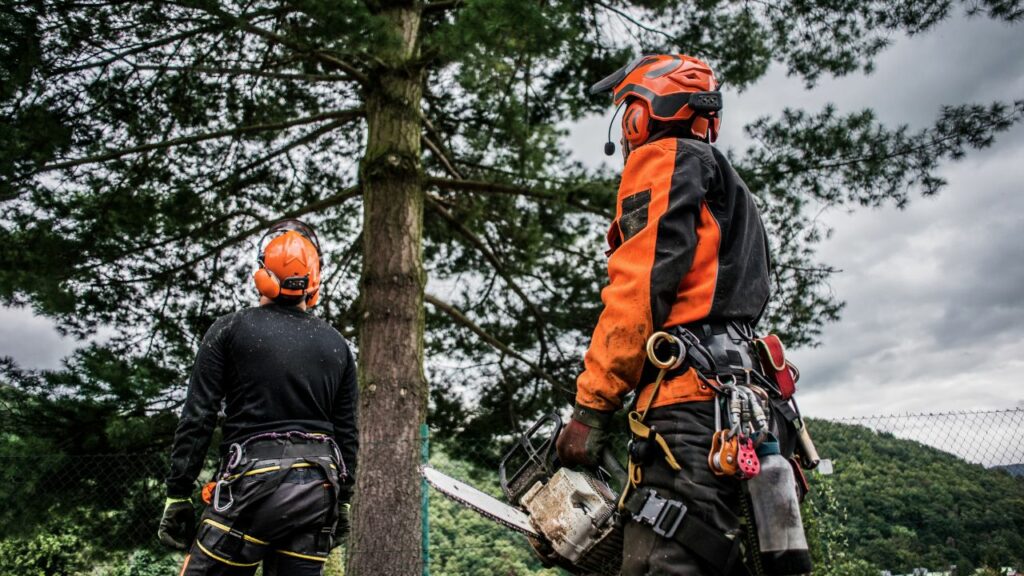
Embracing the correct personal protective equipment (PPE) can make all the difference. Your protective clothing and gear shield you from unforeseen threats, ensuring you’re always prepared without compromising safety. Ensure you’re always well-equipped to maintain safety during chainsaw operations.
Key Body Areas at Risk and Importance of Protective Clothing
While operating a chainsaw, the body parts most susceptible to injury are the left leg, especially when not wearing chainsaw pants, particularly the upper thigh, and the back of the left hand. This is where protective clothing, like chainsaw protection jackets, can offer extra protection. Additionally, the head and upper torso remain vulnerable to falling debris and injuries resulting from chainsaw rotational kickback.
Comprehensive Guide to Head Protection and Visual Protection

A hard hat, being a lightweight yet crucial piece of equipment, safeguards the head against falling debris like branches and limbs, as well as injuries from accidental contact with low-hanging objects. Typically made from durable high-density thermoplastic, the hard hat’s shell is designed to resist impacts and falling debris.
When working in areas where there’s a potential risk of injury from falling objects, the importance of wearing a protective hard hat cannot be emphasized enough. For those involved in tree-felling activities, the necessity begins as soon as they step out of their vehicle. There are countless unpredictable occurrences: branches can drop unexpectedly, saws might eject debris from trees, or climbers might accidentally let go of equipment. These risks highlight the need for robust head protection.
Interestingly, many saw operators, while wearing visual protection, report being struck on the sides and top of their head. This suggests that opting for a helmet equipped with side protection and a securing chin strap can further enhance safety. When selecting a hard hat, there are certain markers to look for, ensuring the utmost protection. A reliable helmet will prominently display essential information on the inside, such as:
- The manufacturer’s name or identification
- The manufacturing date
- The specific type and class of the helmet
- The suitable head size range
- The stamp “ANSI Z89.1”, signifies adherencewith the safety standards set by the American National Standards Institute.
However, it’s crucial to remember that like all safety equipment, hard hats have a lifespan. Regularly inspect your helmet before use. Inspect for any indications of wear or damage, such as dents, cracks, flaking, discoloration, or a degraded appearance. The interior liner also deserves attention. If it’s showing signs of wear or any damage, replace it without delay. Even if a hard hat visually seems in good condition, it’s good practice to replace it within a three to five-year window or as per the manufacturer’s specific recommendation. After all, protection should always be of the highest importance, and ensuring your equipment is in optimal condition is a significant part of that commitment.
Choosing the Right Hard Hat
For optimal protection, a hard hat should comprise three primary components: the shell, the suspension, and the chin strap. Ensure these parts are undamaged, fully functional, and worn correctly. Refrain from drilling ventilation holes in a hard hat unless it was manufactured with them. Some manufacturers design hard hats with visual protection ventilation ports, but these can sometimes allow small debris to enter.
Routine Hard Hat Inspections
Before every use, inspect your hard hat for any cracks or damages that might compromise its protective capability. If it doesn’t revert to its original lightweight form or shows cracking, it’s time for a replacement. Factors like prolonged sunlight exposure, chemical exposure, and age can make the shell brittle and less effective. Regularly testing the elasticity of the hard hat is crucial. If it doesn’t revert to its original shape or displays indications of cracking, it’s moment for a replacement. Fading color or a chalky appearance are other indicators that the hard hat might be compromised.
Replacing Worn-Out Hard Hats
Generally, hard hats should be replaced every five years from their manufacture date or earlier if they show any signs of wear or damage. Lightweight designs that don’t compromise on safety are often preferred. You can locate the manufacture date stamped inside the hard hat, displayed with two dial symbols.
Properly Wearing a Hard Hat
For maximum safety, position the hard hat squarely atop your head, ensuring it faces forward. Maintain a gap between the shell and the suspension. Storing objects inside or wearing other headgear beneath can compromise safety. Lastly, while often overlooked, the chin strap plays a vital role in keeping the hard hat securely in place, especially in challenging conditions like strong winds or when working in elevated areas.
Protective Gear Essentials
Equipping oneself with the right personal protective equipment and protective clothing, such as chainsaw pants and visual protection, ensures an added layer of extra protection against potential hazards.
The recommended PPE for chainsaw operation encompasses a hard hat, safety chaps that are cut-resistant, and protection for both the eyes and ears. Given the high injury risk, even those assisting the chainsaw operator should don the complete recommended protective clothing kit.
Protecting Face and Hearing

Shielding your eyes is vital. Visual protection, such as safety glasses or goggles, can prevent debris from injuring your eyes.Remember that regular corrective glasses or sunglasses are not a substitute for protective equipment for the eyes. If needed, use safety goggles over your regular glasses or a face shield.
Wearing appropriate eye protection, such as safety glasses with side shields, safety goggles, or face shields, is vital. Always ensure they meet accepted standards like the CAN/CSA Standard Z94.3-15: Eye and Face Protectors. Remember, a face shield alone without visual protection glasses isn’t enough to provide complete eye protection.. Visors and goggles significantly reduce the risk of chips entering the user’s eyes. While chainsaws with well-maintained blades typically produce chips of uniform size and speed instead of sawdust, it’s essential to note that chips can still pose a hazard. Many users opt for safety glasses or goggles, but the best choice often depends on the environment. In hotter climates, a lightweight visor might offer better ventilation during rigorous tasks. For maximum safety, consider using both safety goggles and a lightweight visor. In the EU, visors should meet the EN1731 standard, and glasses should comply with EN166.
Tip: Keep your safety glasses pristine, and consider applying an anti-fog coat to deter condensation.
Some chainsaw-specific hard hats come with clear plastic or mesh face shields. These shields are an added protective layer but don’t replace the need for safety glasses.
Power tools like chainsaws pose considerable risks, especially when considering how loud is chainsaw decibels. Gas-powered chainsaws can reach sound levels up to 110 decibels, which can harm hearing over extended periods. Hence, whenever the chainsaw is running, ensure you’re wearing personal protective equipment for your ears.
Ear Protection Choices:
Earplugs: Made of soft plastic or foam, these are inserted into the ear canal. While cost-effective and efficient, comfort can be an issue for some users.
Tip: To insert earplugs properly, straighten the ear canal by pulling up on the ear and then place the plug inside.
Earmuffs: These are designed to cover the entire ear snugly. They vary in styles and the level of protection they offer. Some chainsaw hard hats even come equipped with earmuffs. For optimal protection, the earmuffs should seal the ears entirely.
In certain scenarios, combining earplugs with earmuffs might be beneficial. This combination doesn’t necessarily amplify the sound reduction but heightens the overall hearing protection.
Protecting Extremities
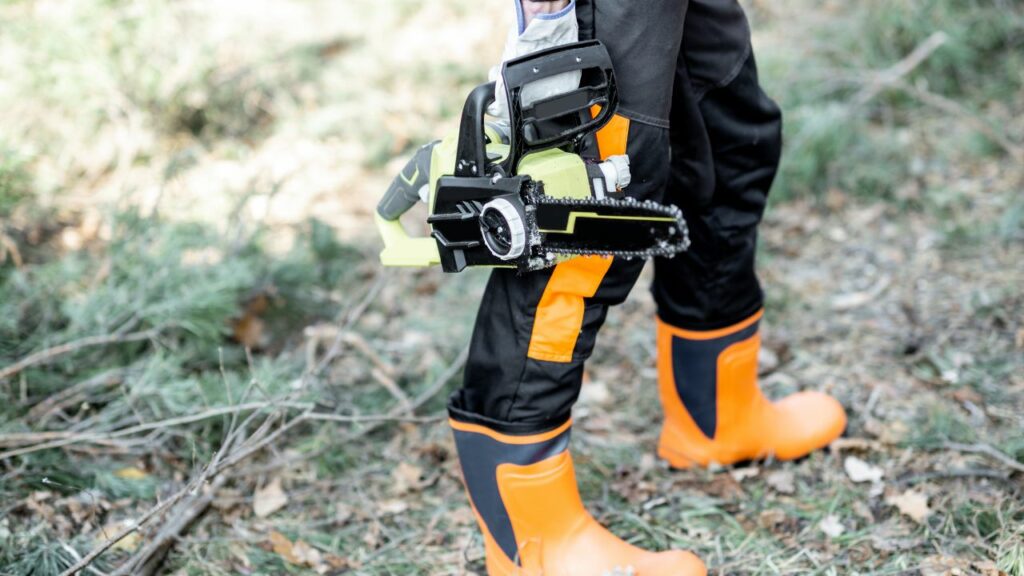
Cutting scenarios often present hazards to feet and ankles, whether due to inaccurate cuts or accidental trips. Therefore, always don protective clothing like heavy-duty work boots or shoes that provide ample ankle protection when using a chainsaw. Opting for footwear with steel toes or safety toes adds an extra protection layer, protecting your toes from potential chainsaw cuts or weighty debris impact. While cut-resistant safety boots offer the zenith of foot protection, it’s worth noting that they might feel considerably warm during extended use.
Opt for heavy-duty, well-fitted safety work boots that meet the CAN/CSA Standard Z195-14 (R2019): Protective Footwear. These boots, especially those made from cut-resistant materials like ballistic nylon, offer superior protection against running chainsaws. Depending on the working environment, consider boots with rubber soles for wet conditions or specialized soles for rough terrains.
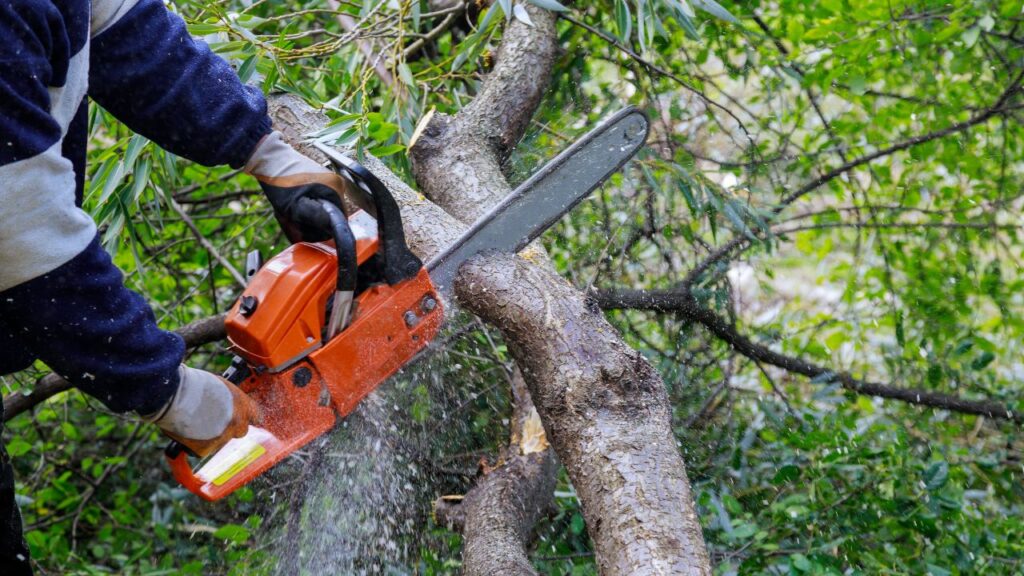
Though not a strict requirement, shielding your hands is a prudent measure, preventing injuries from abrasions, cuts, and burns. Especially when you’re undertaking saw maintenance, changing, or sharpening a chain, always adorn gloves; these situations pose a heightened risk of compromising safety. Apart from their protective nature, gloves can augment your grip on the chainsaw, ensuring better control. Chainsaw pants and jackets are also critical components of the protective clothing ensemble. Although cut-resistant gloves offer a high degree of protection, they tend to be stiffer, which might make maneuvering the chainsaw a tad challenging.
Choose leather gloves enhanced with ballistic nylon on the back. They not only offer an excellent grip but also help absorb vibrations and protect hands during the chainsaw sharpening process. Additionally, operators should consider a leather mitt for the left hand that can rotate freely on the chainsaw’s front bar. This safety mitt keeps the hand on the bar if a kickback occurs, enabling better control and easier chain brake engagement. Most safety mitts cater to protection class 0 (up to 16 m/s chain speed), but some offer protection up to class 1 (20 m/s chain speed).
User Experience with Chainsaw Safety Gear: Real Stories from the Field
It’s always beneficial to hear from those who’ve put chainsaw protection gear to the test in real-life situations. Here are a couple of experiences shared by users:
Jake’s experience with the HuskGuard Pro safety helmet is a testament to the importance of personal protective equipment:
Jake, a professional lumberjack, shared his experience with the HuskGuard Pro safety helmet. “I’ve tried several helmets over the years, but this one stands out. The visor’s clarity and the adjustable ear muffs made it comfortable for long hours. Once, a falling branch hit me unexpectedly, and I’m convinced the reinforced design saved me from a more serious injury.”
Maria’s Encounter with StihlMaster Gloves:
Maria, a hobbyist who indulges in woodworking during weekends, stated, “My StihlMaster gloves not only provide a fantastic grip but they’ve also saved my fingers more than once. I remember cutting a particularly tough log when my chainsaw slipped. Thanks to the reinforced fabric, I only ended up with a minor scratch rather than a deep cut.”
It’s evident from user stories that investing in top-notch safety gear is imperative, not just for professional use but also for personal projects.
Chainsaw Safety Gear Comparisons: Delving Deeper
To help you make an informed decision, we’ve conducted a comparison of popular chainsaw safety gear models in the market. Power tools like chainsaws require the best protective gear:
| Model | Power Resistance | Durability | Comfort Score | Price |
|---|---|---|---|---|
| HuskGuard Pro Helmet | High | 5 years | 9/10 | $120 |
| ChainSafe Elite Vest | Medium | 4 years | 8/10 | $75 |
| StihlMaster Gloves | High | 6 years | 10/10 | $50 |
| TimberGuard Trousers | Medium | 3 years | 7/10 | $90 |
From our analysis, while the HuskGuard Pro Helmet might be on the pricier side, its high power resistance and comfort score make it an excellent investment. On the other hand, the StihlMaster Gloves, though affordable, excel in both durability and comfort.
For readers keen on diving deeper into product specifications and user feedback, you might find our article on the best product reviews related to chainsaw safety gear insightful. This article provides an in-depth analysis and comparison of leading brands, helping you make the right choice.
Ensuring Visibility and Protection
When operating near traffic or during hunting seasons, donning a high-visibility safety vest and protective clothing is not just recommended but often mandated. This equipment not only increases your visibility to others but also significantly reduces the risk of compromising safety and unintended accidents.
Chainsaw Attire Recommendations
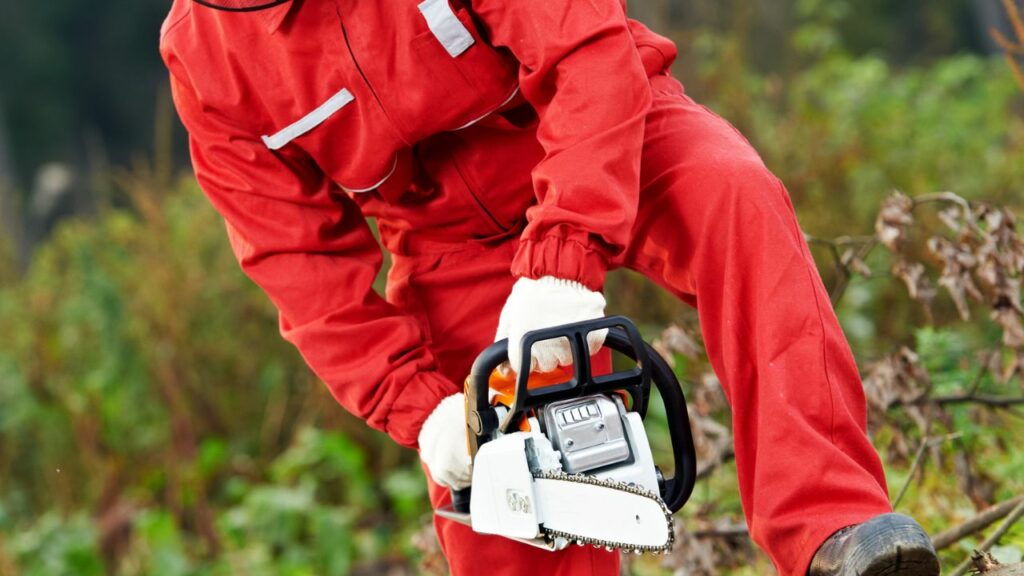
Beyond the specialized protective equipment, choose your attire wisely. Wear lightweight, snug-fitting clothes that lack loose or frayed edges, minimizing the risk of them getting caught in the power tools or tangled in debris. If your work necessitates high-visibility safety vests, opt for the tear-away variety for added safety in case the saw catches onto them.
Selecting the Right Chainsaw Pants
Specialized fabrics have been designed for chainsaw protection clothing, with advancements continuing. Traditional fabrics provide no defense against an active chainsaw as they’re easily cut. Lightweight and flexible clothing is essential to avoid compromising safety. Designing fabric that’s both protective against more severe impacts and also light, flexible, and comfortable for users is a challenge. Overly thick or restrictive clothing can be a safety hazard, as it may cause the user to overheat or restrict movement. While added layers improve cut resistance, completely cut-proof attire is unrealistic, especially with the advancement in saw and chain technology outpacing fabric technology.
The chain speed of your chainsaw, mentioned in its manual, should influence your choice of trousers. While higher class trousers offer more protection, they’re also pricier, warmer, and heavier. Two standard trousers exist: Type A, which protects only the front of the legs and can be worn as chaps or regular trousers; and Type C, which offers all-around leg protection and is typically worn as standard trousers. Chaps are ideal for occasional use, whereas professionals might prefer Type A or C trousers depending on their job role and the potential risks involved.
The mechanism behind chainsaw protective fabric is ingenious. The external layer is durable and slippery to guard against minor damages. Beneath this, long fibers of materials like polyester or Kevlar are layered. In the event of a chainsaw making contact, the inner fibers get pulled and wrap around the chainsaw’s sprocket, halting its chain and limiting potential harm. The trousers’ design is slightly loose to ensure that in the event of a mishap, the excess fabric gets entangled with the chainsaw’s mechanism, stopping it. Such chainsaw pants, once damaged, should be discarded. Chainsaw protection trousers in the EU adhere to EN ISO 11393-2:2018 standards.
When operating a chainsaw, it’s paramount to wear leg protection consistently. One prevalent leg protection method is the use of cut-resistant safety chaps, also known as chainsaw pants or chaps. These chaps are not cut-proof but significantly reduce the likelihood of injury.
For the legs, consider trousers or chaps fortified with sewn-in ballistic nylon pads. Trousers that extend to the belt line generally offer better security than those that stop at the upper thigh. Moreover, wear close-fitting attire made of close-woven fabrics and without cuffs for added safety.
The Mechanics of Safety Chaps
The exterior of chainsaw protection chaps is rugged, while the interior boasts elongated strands made of materials such as nylon, polyester, Avertic, or Kevlar. When the moving chainsaw chain contacts the chaps, it severs the external layer, triggering the interior strands to ensnare the drive sprocket, decelerating or halting the chain.
Chap Varieties
Safety chaps come in three designs:
- Apron Chaps: Protect the front part of the leg, starting from the hips and reaching slightly past the boot top.
- Calf-wrap Chaps: Offer the same protection as the apron style but also envelop the entire calf.
- Full-wrap Chaps: Furnish comprehensive protection, covering the whole leg, including calves and thighs.
It’s essential to ensure that your chosen chainsaw safety chaps are certified by the Underwriter Laboratories (UL) for the stipulated leg protection level.
Choosing and Wearing Chaps Correctly
Safety chaps should be worn over your regular clothing. A snug fit is crucial for the chaps to function effectively. When buying, consider the chap’s length and how it’s measured. For optimal protection, ensure all chap straps are securely fastened, and the chaps extend to the top of your foot.
Maintaining Your Chaps and Gloves
Clean your chaps and gloves according to manufacturer guidelines, typically using a mild detergent and air-drying. If they ever get damaged, especially if the internal fabric is exposed, replace them immediately.
Selecting the Right Chainsaw Protection Jackets
Similar to trousers, chainsaw protective jackets in the EU meet the EN381-11 standards. Their protective materials aim to slow and clog the chainsaw’s cutting mechanism rather than offer complete protection.
Chainsaw Certification Logos
In the EU, chainsaw protection items, including trousers, boots, and gloves, are mandated to bear a distinctive chainsaw logo. This emblem not only confirms that the fabric has undergone testing to ensure its protective qualities but also indicates the protection class and the approved maximum chain speed.
Essential Safety Add-ons

First Aid Essentials
In countries like the UK and Germany, forestry workers are obligated to have a first aid kit on hand. This equipment should, at the very least, contain a substantial wound dressing to address any immediate injuries.
Communication Devices for Emergencies
For UK forestry workers, carrying a whistle is advised. Though colleagues might be in close proximity, the roar of an operating chainsaw can drown out calls for assistance. A whistle’s piercing sound can signal distress more effectively in such noisy environments.
In Germany, there’s an innovative solution to assist forestry workers. The “Hilfe im Wald” app, translated as “Help in the Forest,” shows the most immediate safety point where ambulances can reach. These designated safety spots are easily identifiable by poles with orange tops, each marked with a unique number. Ambulance services are familiar with these numbers, ensuring swift response times during emergencies.
Precautions Against Falls
Utilizing Fall Protection Equipment- It’s essential to know when to employ fall protection equipment. These can range from body belts and harnesses to lanyards. Each serves a critical role in preventing unnecessary injuries from unforeseen falls.
A Glimpse into the History
In the early 1980s, Kjell Eng of Engtex, who was curious about who invented the chainsaw due to his background as an ex-logger, envisioned using textiles for cut prevention. He understood the risks associated with chainsaws, likely pondering their origin and evolution. The first protective fabric developed under his guidance consisted of a layered tricot fabric, which, upon contact with a chainsaw, would peel off layer by layer. This marked the beginning of chainsaw protective fabric. The initial fabrics, while reducing injuries, couldn’t prevent deep cuts or fatal injuries.
By the mid-1980s, Eng introduced the second-gen chainsaw protection, with the first patent awarded in 1989. The third-gen protective fabrics emerged in 1992 under the name Avertic. With novel combinations of settings, materials, and finishes, Avertic surpassed its predecessors in washability and protection levels. This innovative fabric is now a staple in various chainsaw safety gear worldwide. The quest for improved protection continues, with manufacturers working tirelessly to enhance safety for forestry and logging professionals.
In Conclusion
Safety should always be at the forefront when operating machinery like chainsaws. From the shoes you wear to the gloves that protect your hands, every piece of personal protective equipment plays a crucial role. By prioritizing your safety and ensuring you’re properly equipped, you can confidently and securely undertake any chainsaw-related task. Remember, the right gear not only safeguards you but also enhances your efficiency and effectiveness on the job.
